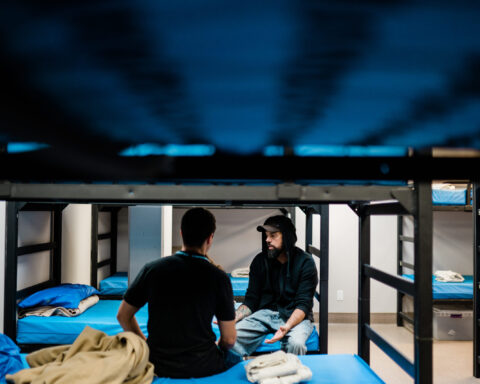Hermie Garcia arrived in Canada in 1984, shortly after he and his wife, Mila Astorga-Garcia, were released from a military prison for being part of the left-wing underground movement in the Philippines. After trying to find work in Canadian mainstream media and failing for not having Canadian experience, the couple started the Philippine Reporter in 1989. 25 years later, they continue to run the paper from their home. With a circulation of 12,000, the paper serves some of the nearly 200,000 Filipinos in Toronto, out of the close to 500,000 Filipinos in Canada. Every year, about 30,000 Filipinos arrive in Canada as permanent residents.
Here is a condensed and edited version of an interview conducted by NCM Reporter Maria Assaf with the newspaper publisher shortly after the 25th anniversary celebrations:
Q: Many newspapers are facing a crisis as they lose readership to online media. How does your paper manage to stay afloat after 25 years and what sets you apart from other Filipino community papers?
A: We listen to the community and we interact with a lot of groups and sectors of the community, so that we have a strong sense of their interests, their concerns, their issues. There’s the issue of immigration, of temporary foreign workers, issue of caregivers, issue of jobs for immigrants, issue of family reunification. We interview them, we get their opinions, we get their views, we get their life-stories, and then the response of the government, the provincial and municipal. So people find stories in our paper that impact their lives.
Q: How do you find out what issues your community cares about the most?/
A: We attend dozens and dozens of events going on in the community every week in many areas of Toronto, so we take pains in talking to not only the readers, but the members of organizations. We attend the meetings, we interview them, we read their newsletters and publications, we read their websites. So we have a strong sense of what’s happening in the community.
Q: What is the biggest challenge ethnic media faces in comparison to mainstream media?
A: Most of the ethnic media, be it newspapers or magazines or radio programs or TV programs or online publications, they don’t have the resources of the mainstream media. The mainstream media have hundreds of millions in revenue. Except for publications like Canadian Immigrant, which is owned by Torstar (publishers of the Toronto Star), all the ethnic media publications are small businesses, so they don’t have the millions, they don’t have the big printing presses, they don’t have hundreds of members of staff, most of these are family-run, what you would call mom-and-pop businesses.
Q: What do you think small ethnic media can provide that others can’t?
A: Publications like Canadian Immigrant, in addition to being owned by a corporate mainstream media, its approach is also different. It wants to cover all the ethnic communities. They are somewhere above the communities. But most of the ethnic media outlets, they cover specific communities. We are more deeply connected to the community. For example, we have a story coming out tomorrow about [federal Minister] Jason Kenney stating that Filipinos are abusing the live-in caregiver program for purposes of family reunification. That’s a very strong statement. Then they announced some changes in the temporary foreign workers programs. These were covered by the mainstream media, like Toronto Star, Globe and Mail. We also covered them, but we got reactions from community groups, community leaders. So that’s the difference. We are not confining ourselves to job-hunting stories.
[W]e have a story coming out tomorrow about [federal Minister] Jason Kenney stating that Filipinos are abusing the live-in caregiver program for purposes of family reunification. That’s a very strong statement.
Q: With a staff of only about seven full-time people in Toronto, how do you manage to cover stories from all over Canada?
A: We know people from other cities, like Montreal, Vancouver, Winnipeg. We have connections with some groups, some individuals who can occasionally write for us and who occasionally volunteer stories to us or send pictures or press releases or cover stories in their areas. Because we’ve been in operation for 25 years, it’s not that hard. You know a lot of people. We know sources, we know the leaders, we know the groups, we know the organizations, we know when events are held. It is not hard to find writers. There are so many potential writers and former writers and reporters and journalists in the community.
Q: How did you get fresh foreign content at the beginning?
A: We couldn’t afford to pay correspondents in Manila, especially at that time. We called our friends in the Philippines in the media and asked them to send stories and we paid them not their rates, but some kind of discounted rates, because we were friends. We asked some newspapers there to send stories to us for re-print. We went the extra mile. We were the first newspaper in the Filipino community to use a fax machine. We even asked the papers in Manila to fax pictures so we could use them on page one in our newspaper.
Q: Tell me about the challenges you faced when you started the paper.
A: When you have limited resources, limited equipment and limited staff — writing staff and office staff — it is very hard to sustain a business, because you cannot afford to lose money indefinitely. Especially when the market is relatively small. We learned not to confine ourselves to our community for advertising revenue. It was a losing proposition for the first few years. But we didn’t stop. I was thinking we would grow, we would become stable, we would make money and continue publishing a paper that is self-sustaining and we succeeded. It was very hard at the start. Especially before I quit my job, we would work only at night and on weekends. My wife and my family sacrificed a lot to produce this paper for a long time.
It was very hard at the start. Especially before I quit my job, we would work only at night and on weekends. My wife and my family sacrificed a lot to produce this paper for a long time.
Q: What made you think you could start a new paper in a city that already had about five Filipino community papers, when the community was much smaller?
A: I didn’t have any business experience in the Philippines. What I thought was that if these community papers that existed then … some of them were not run by journalists, they were run by business people who didn’t have any journalistic background. I thought if they could do it, may be I could do it too. I thought I could produce something with quality. In the Philippines, I was a journalist for many, many years. I worked as a magazine writer, later as a reporter and later as a desk editor of two daily newspapers. Because of my experience and my wife’s experience — she was also a reporter at a business daily for a long time — I had the feeling that content-wise, it’s not hard to produce a newspaper. Lots of those papers were covering entertainment stories, there was a lack of serious stories. Some of the newspapers then were using old stories, from months and weeks ago. They were already stale. [Mila Astorga-Garcia is co-publisher and managing editor.]
Q: How has your paper coped with the growth of the Filipino community in Canada?
A: We always get calls, we always get e-mails, we always have people tell us personally, “We need more copies of the paper,” … “In this store we don’t have copies of the paper,” in these far away, far away rural areas. We have to print more so we have to spend more, and we have to get more advertising revenue. Because our newspaper is free, what we do is we make distribution more efficient. We make sure that not too many copies are wasted. We visit outlets regularly and if we find that the old issues are still there, we reduce the number of copies and take them to other outlets. If there’s a party or an event, we deliver the newspaper. At that time we covered more stories from the Philippines, because not much was happening in the community [here], now there are more activities, more events, more people, so more stories.
Editor’s Note: At the 25th anniversary celebrations, Garcia printed T-shirts with the words “Stop killing journalists”. Many journalists have been killed in the line of duty in the Philippines. There’s a campaign among journalists there and their supporters to prosecute the perpetrators — mostly politicians, police and military who were subjects of the journalists’ investigative stories, according to Garcia.




